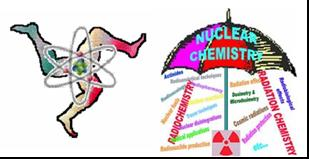Dr
Olga Feynberg
(NRC "Kurchatov Institute"), Prof.
Victor Ignatiev
(NRC "Kurchatov Institute")
19/09/2011, 11:00
Waste Transmutation and Generation IV Reactors
oral presentation
Last decade, systems with liquid fuel on the base of molten salts attracted attention as potential dedicated burners of transuranium (TRU) elements from LWR spent fuel. Kurchatov Institute with partners contributed to Molten Salt Reactor (MSR) development within ISTC#1606 and #3749 tasks. Within these projects key technical solutions for development of promising TRU transmuter concepts were...
Mr
Dag Eriksen
(Primus.inter.pares AS, Norway)
19/09/2011, 11:20
Waste Transmutation and Generation IV Reactors
oral presentation
Nuclear technology utilizes several stable nuclides, but not necessarily as isotopically pure materials. One example is boron, where B-10, abundance 19.9%, has a high thermal neutron absorption cross section utilized in neutron detectors, but natural boron is used despite the fact that the 80.1% abundant B-11 is not contributing. In Generation IV-reactor concepts fuels sustaining high...
Dr
K. R. Kim
(Korea Atomic Energy Research Institute)
19/09/2011, 11:35
Nuclear Fuel Cycle
oral presentation
Metal electrowinning is the process of winning metal ions from an electrolyte to a solid form on a cathode by passing an electric current through the electrolyte. In the uranium electrowinning literature, only a limited number of multiphysics modeling studies have been taken place for the comprehensive understanding of the complexity in this process. A computational electrochemo-fluid dynamics...
Ms
Julia Bisson
(CEA-Marcoule, France)
19/09/2011, 11:50
Nuclear Fuel Cycle
oral presentation
In the context of nuclear fuel reprocessing and in order to reduce the nuclear waste radiotoxicity, new ways to selectively extract actinides from spent fuels are studied. Among them the GANEX process (for Group ActiNides Extraction) is based on a homogenous recycling of actinides. All actinides (U(VI), Np(V et VI), Pu(IV), Am(III), Cm(III)), present in a highly acidic aqueous solution, would...
Dr
Yury Pokhitonov
(Khlopin Radium Institute)
19/09/2011, 12:05
Nuclear Fuel Cycle
oral presentation
One of the most important conditions for the realization of the concept of closed nuclear fuel cycle consists in the availability of highly developed infrastructure, including reprocessing of spent nuclear fuel (SNF), and further utilization of the resulted waste. The major way for increasing the safety of radwastes management is the development of advanced technologies, which would enable to...
Dr
Mikhail Alyapyshev
(Khlopin Radium Institute)
19/09/2011, 12:20
Nuclear Fuel Cycle
oral presentation
The treatment of the high level waste generated during nuclear fuel reprocessing is the obligatory stage of the nuclear fuel cycle. The reducing of volume of nuclear wastes could be realized by recovering of all harmful radionuclides (actinides, lanthanides and fission products) to separate fractions and their encapsulating in appropriate stable matrices. Separation of minor actinides (Am and...
Dr
Dmitry Kirsanov
(StPetersburg University), Dr
Vasiliy Babain
(Khlopin Radium Institute)
19/09/2011, 12:35
Nuclear Fuel Cycle
oral presentation
PUREX process of spent nuclear fuel (SNF) reprocessing requires thorough analytical monitoring at every technological stage to minimize economical losses and ecological risks. Spectrophotometric determination of various ions in visible and near UV spectral range is a classical analytical method. It can be successfully employed for determination of various oxidation states of actinides in...
Mr
Paresh Prajapati
(The M. S. University of Baroda, Vadodara, India-390002)
19/09/2011, 12:50
Nuclear Fuel Cycle
oral presentation
232Th-233U fuel cycle in connection with ADSS is one of the possibilities for power generation besides transmutation of long-lived fission products and incineration of long-lived minor actinides. The 232Th-233U fuel in AHWR and ADSS has an advantage over the present reactors based on uranium fuel from the point of thousand times less radio toxic wastes production. Besides these, thorium in the...
